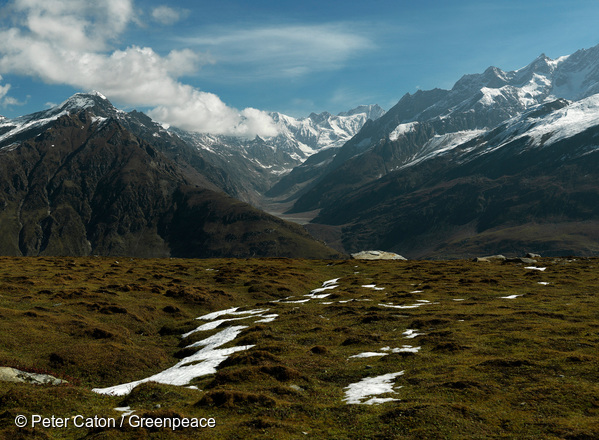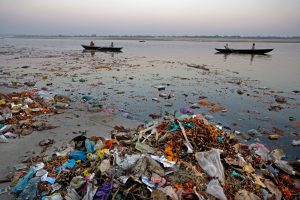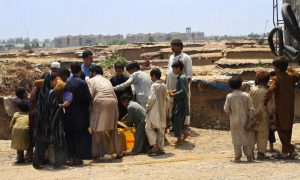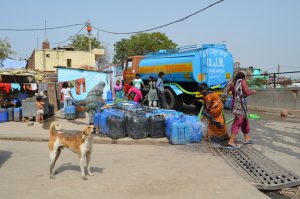India has placed special emphasis on the strong adverse impacts of climate change on water and on the Hindu Kush Himalayas in the country’s national climate plan submitted to the UN, also known as an Intended Nationally Determined Contribution (INDC).
The Hindu Kush Himalaya is also called ‘the third pole’ because it holds the largest store of fresh water after the North and South poles. The world’s tallest mountain range is the primary source of water for most of Asia, including three river basins crucial to South Asia – Indus, Ganga and Brahmaputra.
thethirdpole.net has consistently reported on these links and also on the need for better cooperation between Asian countries on transboundary river basins, another point mentioned in India’s INDC.
See also: India promises 33-35% emissions intensity drop by 2030
Submitted in the early hours of the anniversary of Mahatma Gandhi’s birth – October 2 – to the United Nations Framework Convention on Climate Change, India’s national plan identifies water as the “most critical component of life support system”.
Pointing out that water availability is being impacted by climate change, and that the country has an urgent need to adapt to this, the INDC says, “The adaptation strategies for the water sector focus on enhancing efficient use of water, ensuring access and tackling the adverse impact of climate change. The trans-boundary and regional issues also need to be factored in.”
The steps
Outlining the steps being taken for this adaptation, the INDC points out, “The main objective of India’s National Water Mission (NWM) is conservation of water, minimising wastage and ensuring its more equitable distribution both across and within states through integrated water resources development and management. One of the key goals of the mission is to enhance water use efficiency by 20%.”
The NWM is one of the eight missions under India’s 2008 National Action Plan on Climate Change. Now the government plans to add four missions or programmes to the plan.
India is the world’s largest groundwater user, resulting in a steep decline in many water tables across the country. The INDC talks about the importance of rainwater harvesting. The government has recently approved a programme called Neeranchal to push watershed development.
And then there is the National Mission for Clean Ganga which has activities such as measuring and policing pollution and laying sewage networks, treatment plants and so on. A National River Conservation Directorate has recently been set up with a remit to conserve rivers, lakes and wetlands in the country, plus improve improving the water quality in stretches of 40 rivers in 190 towns spread over 20 states.
Climate change is also speeding up of the water cycle, which effectively means more droughts and more floods. India’s INDC points out that 45.64 million hectares of the country are flood prone.
Many environmentalists are likely to be upset by the extent to which the government has emphasised hydropower in its move away from fossil fuels. India now has an installed capacity to generate 42 GW of electricity through large hydro projects, and 4 GW through small projects (up to 25 MW).
The INDC says, “With a vast potential of more than 100 GW, a number of policy initiatives and actions are being undertaken to aggressively pursue development of country’s vast hydro potential.” However, it also promises to promote small and mini hydropower projects and new more efficient water mills to bring electricity to remote villages.
Read also: Small hydro starting to gush along and Policy quagmire threatens small hydro
Himalayan mission
Pointing out that in India alone, the Himalaya range has 9,579 glaciers, some of which form the perennial source of major rivers, the INDC notes that these mountains are“highly sensitive to global warming”.
It refers to the 2008 National Mission for Sustaining the Himalayan Ecosystem which is supposed to address issues concerning the glaciers and associated hydrological consequences; biodiversity and wildlife conservation and protection; traditional knowledge and livelihoods and planning for sustainable development. To complement this, the government is now launching a National Mission on Himalayan Studies. This is expected to build a body of scientific and traditional knowledge along with demonstrating replicable solutions to the problems of natural resource management, capacity building, long-term ecological monitoring and so on.
Sandeep Chachra, head of ActionAid India, said, “India has also rightly put the focus back on the need to adapt to climate impacts. Farming communities, who are already distressed, are suffering even more from erratic and extreme climatic conditions. Small farmers who constitute 84% of the farming households of India are suffering the most. Changes in India’s climate are leading to land and coastal degradation, soil erosion, loss of biodiversity, all of which are already seriously aggravating food insecurity in the country.”
The INDC says, “India’s expenditure on programmes with critical adaptation components has increased from 1.45% of GDP in 2000-01 to 2.82% during 2009-10. Expenditure on human capabilities and livelihoods viz. poverty alleviation, health improvement and disease control and risk management, constitutes more than 80% of the total expenditure on adaptation in India.”








